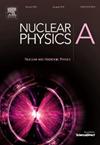Analytical study of conformable fractional bohr hamiltonian with the extended form of the sextic potential
IF 2.5
4区 物理与天体物理
Q2 PHYSICS, NUCLEAR
引用次数: 0
Abstract
New analytical solutions of the conformable fractional Bohr Hamiltonian for triaxial nuclei have been derived, incorporating an extended form of the Sextic potential in the component of the collective nuclear potential, alongside a steep harmonic oscillator in the component. This particular type of potential can specifically recover sextic, Davidson and harmonic potentials in particular cases. The energy spectra and corresponding wave functions are analytically determined through a novel conformable fractional extended Nikiforov-Uvarov method. Additionally, the derivation of the wave functions necessitates the application of the bi-confluent Heun functions. This study examines the relationship between the conformable fractional spectra of the potential and the benchmark spectrum. A systematic analysis is conducted to explore the spectral expansion as a function of both the fractional derivative order and the potential parameters. The normalized transition rates and corresponding energy spectra were computed and systematically compared with experimental measurements. The theoretical predictions demonstrate excellent agreement with empirical data across multiple isotopic chains, including 112,114,116Pd, 120, 126, 128, 130, 132, 134Xe, and 192,194,196Pt.
可调分数玻尔哈密顿算子的解析研究
推导出了三轴核的符合分数玻尔哈密顿量的新解析解,在集体核势的β分量中加入了六次方势的扩展形式,在γ分量中加入了陡谐振子。这种特殊类型的电位可以在特定情况下恢复六次、戴维森和谐波电位。通过一种新颖的符合分数阶扩展Nikiforov-Uvarov方法解析确定了能量谱和相应的波函数。此外,波函数的推导需要应用双合流Heun函数。本研究考察了电位的符合分数谱与Z(5)基准谱之间的关系。系统地分析了谱展开作为分数阶导数阶数和势参数的函数。计算了归一化后的B(E2)跃迁速率和能谱,并与实验结果进行了系统比较。理论预测与多个同位素链(包括112,114,116Pd, 120, 126, 128, 130, 132, 134Xe和192,194,196Pt)的经验数据非常吻合。
本文章由计算机程序翻译,如有差异,请以英文原文为准。
求助全文
约1分钟内获得全文
求助全文
来源期刊

Nuclear Physics A
物理-物理:核物理
CiteScore
3.60
自引率
7.10%
发文量
113
审稿时长
61 days
期刊介绍:
Nuclear Physics A focuses on the domain of nuclear and hadronic physics and includes the following subsections: Nuclear Structure and Dynamics; Intermediate and High Energy Heavy Ion Physics; Hadronic Physics; Electromagnetic and Weak Interactions; Nuclear Astrophysics. The emphasis is on original research papers. A number of carefully selected and reviewed conference proceedings are published as an integral part of the journal.
 求助内容:
求助内容: 应助结果提醒方式:
应助结果提醒方式:


